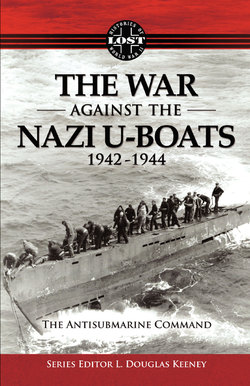Читать книгу The War Against The Nazi U-Boats 1942 – 1944 - L. Douglas Keeney - Страница 3
На сайте Литреса книга снята с продажи.
Foreword
ОглавлениеThe clouds of World War II were casting long and increasingly dark shadows across the face of America. By 1942, with the exception of neutral countries such as Spain, Switzerland and Sweden, the continent of Europe had been overrun by the Germans with just Britain and Russia holding them back from compete domination. On the other side of the world, Imperial Japan had a pincer-like grip on the remainder of the nations with occupation forces stretching from the Aleutians to New Guinea leaving just a narrow sea lane to Australia, which was also in jeopardy. If Japan were to prevail in the East and Germany in the West, North America would be an isolated continent surrounded by hostile nations on both sides.
Thus began the end. The Battle for the Atlantic pitted the Nazi wolf packs against the destroyer escorts of both navies, plus the RAF and, starting in 1942, the United States Army Air Force. But the tool that really did it was the B-24 Liberator. “The VLR [very long range] B-24 Liberator aircraft of RAF 120th Squadron was the weapon system which tipped the battle in favor of the Allies,” wrote Chipman. “What made the aircraft such an effective weapon against the U-boat was their high speed relative to a surface vessel, a speed which permitted them to search a much greater area than a ship.
“In October 1942, the US Army Air Forces entered the Atlantic war by creating several land-based antisubmarine squadrons. Officially known as the US Army Air Forces’ Antisubmarine Command, these units were designed to help the US Navy hunt for enemy submarines, which, at the time, were patrolling along the Atlantic coast and in the Caribbean.
“In November 1942, 21 American B-24s landed in South England and began flying out of St. Eval, Cornwall. Between December and March, they flew several patrols across the Bay of Biscay searching for and attacking various German submarines. On occasion they encountered German Junkers Ju-88 aircraft and had to fight their way back to England.”
This remarkable restoration brings back to life the original 300-page report written by in 1945 by Arthur B. Ferguson, Assistant Chief of Air Staff, Intelligence, Historical Division of the United States Army Air Forces. Ferguson’s fine history reminds us yet again of another crucial mission flown by the World War II airmen. For aviation and history buffs, and all those who enjoy an engaging story exceptionally well told, this is a wonderful addition to your library and the newest installment to our series of books under the banner of the Untold Stories of World War II..
